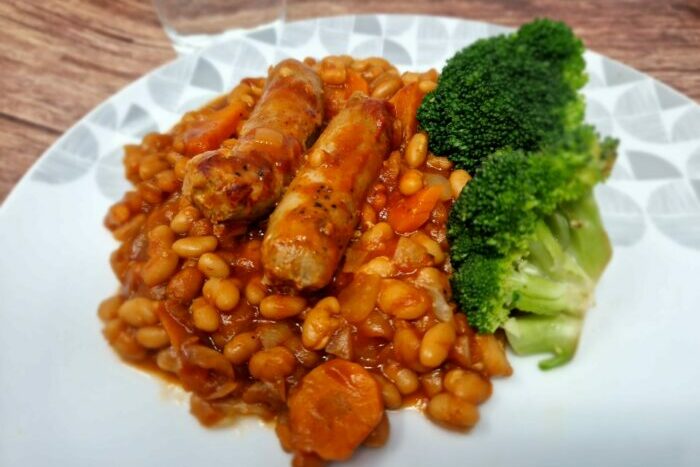Who doesn’t love a sausage hotpot? And this one is so simple! We didn’t brown the sausages in the picture opposite, they browned on top in the slow cooker, so you can definitely skip that step if you’re short on time.
Serve with any green vegetables you like, or some crusty bread to mop up the beans!
Skills Check
Follow a recipe; follow food safety & hygiene rules; tidy away; use measuring spoons; cut using bridge/claw safely; use a tin opener safely.
Equipment
Measuring spoons, tin opener, chopping board, sharp knife.
Allergens
Please note the allergens listed are indicative only. Allergens vary depending on brand; check the labels on the products you use.
Milk | Fish | Soya
May contain wheat | Sulphites
Ingredients (serves 4):
- 8 pork sausages, reduced fat (or a vegetarian/vegan alternative)
- 1 large onion, finely chopped
- 2 carrots, chopped
- 2 x 400g tins of baked beans, reduced salt and sugar
- 2 tbsp tomato puree
- 1 bay leaf
- 1 tbsp Worcestershire sauce (or vegetarian/vegan alternative)
- Pepper, to taste
Method
- Optional step: Brown the sausages in a drizzle of oil in a frying pan for 3-5 minutes.
- Add the sausages to the slow cooker, with the chopped onion and carrot.
- Stir in the baked beans, bay leaf, Worcestershire sauce and season with black pepper.
- Cover and cook on low for 4 hours.
So thinking about Sausage Hot Pot ...

Sausages are a source of protein but they are also high in fat. They are a form of processed meat and should only be eaten in moderation; no more than 70g of red/processed meat per day for adults.
Nutritional Information
| Energy | 1515kJ/360kcal | 18% | |
| Low | Fat | 5.9g | 8% |
| Low | Saturates | 1.9g | 10% |
| Med | Sugars | 18.0g | 20% |
| High | Salt | 2.4g | 40% |
per 317g serving
% of an adult's reference intake
Typical values per 100g: Energy 477kJ / 113kcal
Notes
A traffic light system is used on nutrition labels to make it easier to see which foods and drinks are lower in calories, fat, sugar and salt. Try and choose more ‘greens’ and ‘ambers’ and fewer ‘reds’, and stick to smaller portions of ‘reds’.
Just because a recipe or a food has a red traffic light doesn’t mean you shouldn’t eat it. Understanding why a food or recipe might have a red light can be helpful. For example oily fish is high in total fat and so any recipe containing oily fish is likely to be ‘red’ for fat. But it is recommended that we eat oily fish at least once a week because the type of fat it contains is beneficial for our health.
% Reference Intakes are also shown. Reference Intakes are guidelines about the approximate amount of particular nutrients and energy required for a healthy diet (based on an average-sized woman doing an average amount of physical activity). Most children will require less than these Reference Intakes. The contribution of one serving of a food or drink to the Reference Intake for each nutrient is expressed as a percentage.




